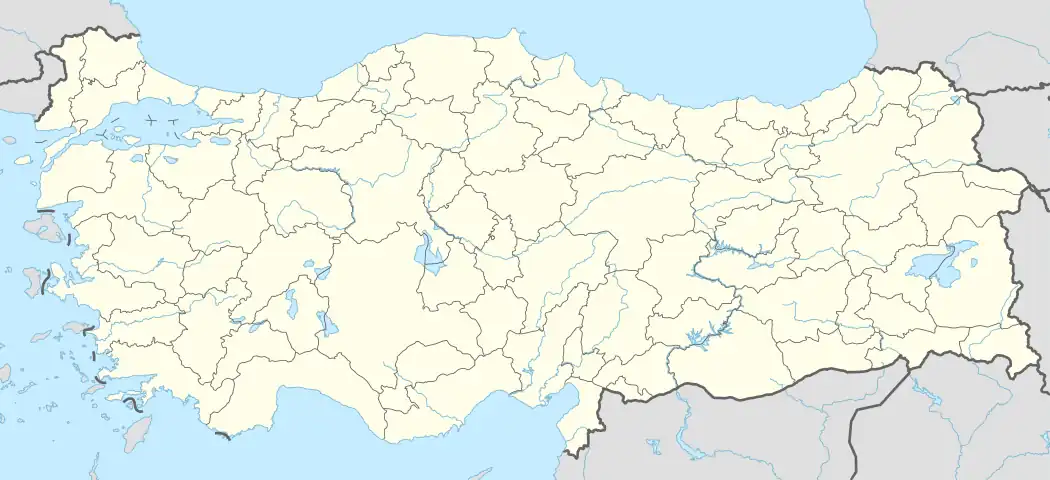Cumalıkızık | |
|---|---|
 | |
 Cumalıkızık Location in Turkey  Cumalıkızık Cumalıkızık (Marmara) | |
| Coordinates: 40°10′30″N 29°10′23″E / 40.17500°N 29.17306°E | |
| Country | Turkey |
| Province | Bursa |
| District | Yıldırım |
| Population (2022) | 707 |
| Time zone | TRT (UTC+3) |
| Official name | Cumalikizik Village |
| Part of | Bursa and Cumalıkızık: the Birth of the Ottoman Empire |
| Criteria | Cultural: (i), (ii), (iv), (vi) |
| Reference | 1452 |
| Inscription | 2014 (38th Session) |
| Area | 8.646 ha (21.36 acres) |
| Buffer zone | 191.917 ha (474.24 acres) |
.jpg.webp)
Cumalıkızık is a neighbourhood in the municipality and district of Yıldırım, Bursa Province in Turkey.[1] Its population is 707 (2022).[2] It is 10 kilometers east of the city of Bursa, at the foot of Mount Uludağ.[3] Its history goes back to the Ottoman Empire's foundation period. The village is now included within the border of the Yıldırım district as a neighbourhood. Cumalıkızık was founded as a vakıf village. The historical texture of the village has been well protected and the civilian countryside architectural structures of the early Ottoman period are still intact. Because of this, Cumalıkızık has become a popular but still unspoiled center for tourists.[4][5]
A group of similar villages which are placed close together between the foot of mount Uludağ and the valleys have been called Kızık in Turkish. The name stands for one of the twenty-four clans of the Oghuz Turks and the people from the villages also called Kızık. Similar villages, less well preserved, are Değirmenlikızık, Derekızık, and Hamamlıkızık (see Kızık for other places named Kızık in Turkey). Hamamlıkızık was the village of the local baths (hamam), and Cumalıkızık was named because people gathered there on Friday (Cuma, in Turkish) for worship.
The Cumalıkızık ethnography museum in the village's square displays historical objects from the village. Every June there is a raspberry festival. The famous Cumalıkızık houses are made out of wood, adobe, and rubble stones. Most of them are triplex houses. The windows upstairs are generally latticed and with a bay window. The handles and knockers on the main entry doors are made of wrought iron. Cobblestone streets are very narrow with no sidewalks, but a typical medieval gutter in the center for rain and waste water.
A mosque, the fountain of 'Zekiye Hatun' next to the mosque and a bath with one dome are original from the Ottoman Empire. There is also a ruin of a church built by Byzantines.
Cumalıkızık holds 270 historical houses. Some of these houses are in process of restoration and maintenance, and 180 of them are still being used as dwellings.
In 1969, the remains of a Byzantine church were unearthed southeast of the village in the foothills of Mt. Uludağ. Some architectural works are on display in the Archeological Museum of Bursa. Movies and television programs with historical settings have often been recorded in Cumalıkızık.
See also
References
- ↑ Mahalle, Turkey Civil Administration Departments Inventory. Retrieved 12 July 2023.
- ↑ "Address-based population registration system (ADNKS) results dated 31 December 2022, Favorite Reports" (XLS). TÜİK. Retrieved 12 July 2023.
- ↑ "Bursa and Cumalikizik Early Ottoman urban and rural settlements". UNESCO. Archived from the original on 4 April 2014. Retrieved 3 August 2015.
- ↑ "Bursa and Cumalıkızık: the Birth of the Ottoman Empire". UNESCO. Archived from the original on 6 September 2015. Retrieved 3 August 2015.
- ↑ "Cumalıkızık ve Bergama Dünya Miras Listesinde". Anadolu Agency. 22 June 2014. Retrieved 23 June 2014.